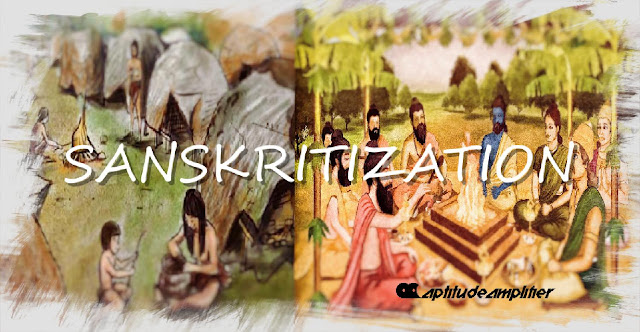The term “ Sanskritization ” for the first time ever was introduced into Indian Sociology by Social Anthropologist Professor Mysore...
The
term “Sanskritization” for the first time ever was introduced into Indian
Sociology by Social Anthropologist Professor Mysore Narasimhachar Srinivas in
1952 as an underlying process of Indian social change, in his book “Religion
and Society Among the Coorgs of South India” and then redefined the term in
1966 in his book “Social Change in Modern India”, which was originally a
lecture delivered in May 1963 at the Rabindranath Tagore Memorial Lectures at
the University of California in Berkeley.
The
concept of Sanskritization appears to have been occurred throughout the Indian
history and nevertheless continues to take place in different parts of India.“Amma
Coorgs exemplify a tendency which has always been present in the caste system:
a small group of people break off from a larger whole of which they are a part,
Sanskritize their customs and rituals and achieve a higher status than their
parent body in the course of a few decades”(Srinivas 1952:35).
Sanskritization has been found to be a widespread socio-cultural process among Hindus in different territories of India, which“is not confined to Hindus but also occurs among tribal and semi-tribal groups such as the Bhils of Western India, the Gonds and Oarons of Central India, and the Pahadis of the Himalayas. This usually results in the tribe undergoing Sanskritization claiming to be a caste, and therefore, Hindu.”(Srinivas 1966:7)
Sanskritization has been found to be a widespread socio-cultural process among Hindus in different territories of India, which“is not confined to Hindus but also occurs among tribal and semi-tribal groups such as the Bhils of Western India, the Gonds and Oarons of Central India, and the Pahadis of the Himalayas. This usually results in the tribe undergoing Sanskritization claiming to be a caste, and therefore, Hindu.”(Srinivas 1966:7)
Sanskritization
is the process of changing one’s social status by giving up lower
section’scharacteristics and adopting higher status’s attributes.Sanskritization
has been defined by M.N. Srinivas as“A low caste was able, in a generation or
two, to rise to a higher position in the hierarchy by adopting vegetarianism
and teetotalism and by sanskritizing its rituals and pantheon. In short, it
look over, as far as possible, the customs, rites, and beliefs of the Brahmins,
and the adoption of the Brahminic way of life by alow caste seems to have been
frequent, though theoretically forbidden. This process has been called ‘Sanskritization’
in this book, in preference to ‘Brahminization’, as certain Vedic rites are
confined to Brahmins and the two other ‘twice-born’ castes”(Srinivas 1952:30).
Srinivas has modified the definition in intervals, among them this stated definition has the broadest sense, “Sanskritization is the process by which a “low” Hindu caste, or tribal or other group, changes its customs, ritual, ideology, and way of life in the direction of a high, and frequently, “twice-born” caste. Generally, such changes are followed by a claim to a higher position in the caste hierarchy than that traditionally conceded to the claimant caste by the local community.”(Srinivas 1966:6)
Srinivas has modified the definition in intervals, among them this stated definition has the broadest sense, “Sanskritization is the process by which a “low” Hindu caste, or tribal or other group, changes its customs, ritual, ideology, and way of life in the direction of a high, and frequently, “twice-born” caste. Generally, such changes are followed by a claim to a higher position in the caste hierarchy than that traditionally conceded to the claimant caste by the local community.”(Srinivas 1966:6)
The
second connotation of Sanskritization is broader in sense because at first
Srinivas had spoked of imitation of mere food habits, rituals, and religious
practices but later on he included imitation of ideologies too (ideas include
Karma, Dharma, Pap, Punya, Moksha, etc)along with the first connotation.The
second definition defined by M.N. Srinivas is broader and more appropriate in
some content was agreed by Yogendra Singh,which he guided as:
- “As per this definition, the imitation group need not be only a low caste group, it can be a tribal or any other group.
- The imitation is not restricted to mere rituals and religious practices. It also means imitation of ideologies.
- Thirdly, the Brahmins do not constitute the only model. It could be any groupoccupying a higher position in the hierarchy. Srinivas admits that it is the locally dominant caste which will be the model. The dominant caste could be Brahmin or Lingayat or Kshatriya or Vaisya, etc.. The criteria of dominance may be ritually higher status, education, economic strength or numerical majority”(C.N. Shankar Rao 2013:235).
“Sanskritization
is generally accompanied by, and often results in, upward mobility for the
caste in question. Sanskritization results only in positional changes in the
system and does not lead to any structural change. That is, a caste moves up,
above its neighbors, and another comes down, but all this takes place in an
essentially stable hierarchical order. The system itself does not change”
(Srinivas 1966:7).To explain the process Srinivas has given few examples of
Sanskritization, “The Rameshwara temple at Irpu and the Tala Kaveri Shrine are
instances of almost complete Sanskritization”(Srinivas 1952:226).Srinivas has also
discussed that “it is not inconceivable that occasionally the de-Sanskritization of the imitating castes may take place” (1985:62), (1993:353).
___________________________________________________________________
Visit some other related topics – Brahminization,
Sanskritization over Brahminization, De-Sanskritisation, Indology
Reference:
- Srinivas, M.N. (1952). Religion and Society Among the Coorgs of South Indian.Asia Publishing House.
- Srinivas, M.N. (1966). Social Change in Modern India. Orient Blackswan Publications.
- Shankar Rao, C.N. (2004). Sociology of Indian Society (Revised Ed.). S. Chand and Company Private Limited.
- Nagla, B.K. (2008). Indian Sociological Thought. Rawat Publications.
- Ahuja, Ram (1993). Indian Social System. Rawat Publications.
___________________________________________________________________
Related
Questions:
The
Concept of Sanskritization
What
is Sanskritization?
Meaning
of Sanskritization.
Definition
of Sanskritization
Aptitude Amplifier ©2017. All Rights Reserved.











![Validate my RSS feed [Valid RSS]](https://www.feedvalidator.org/images/valid-rss-rogers.png)
